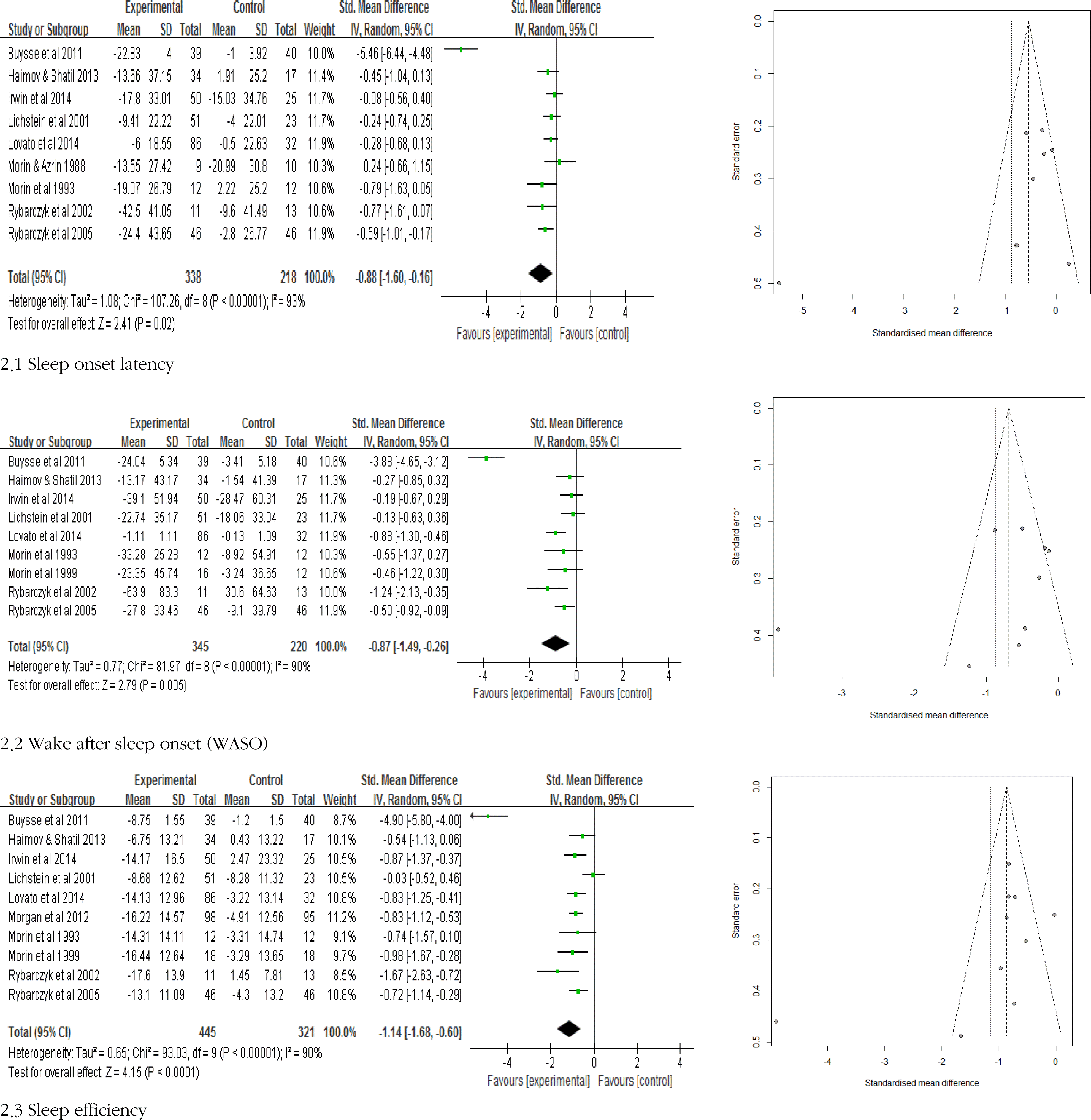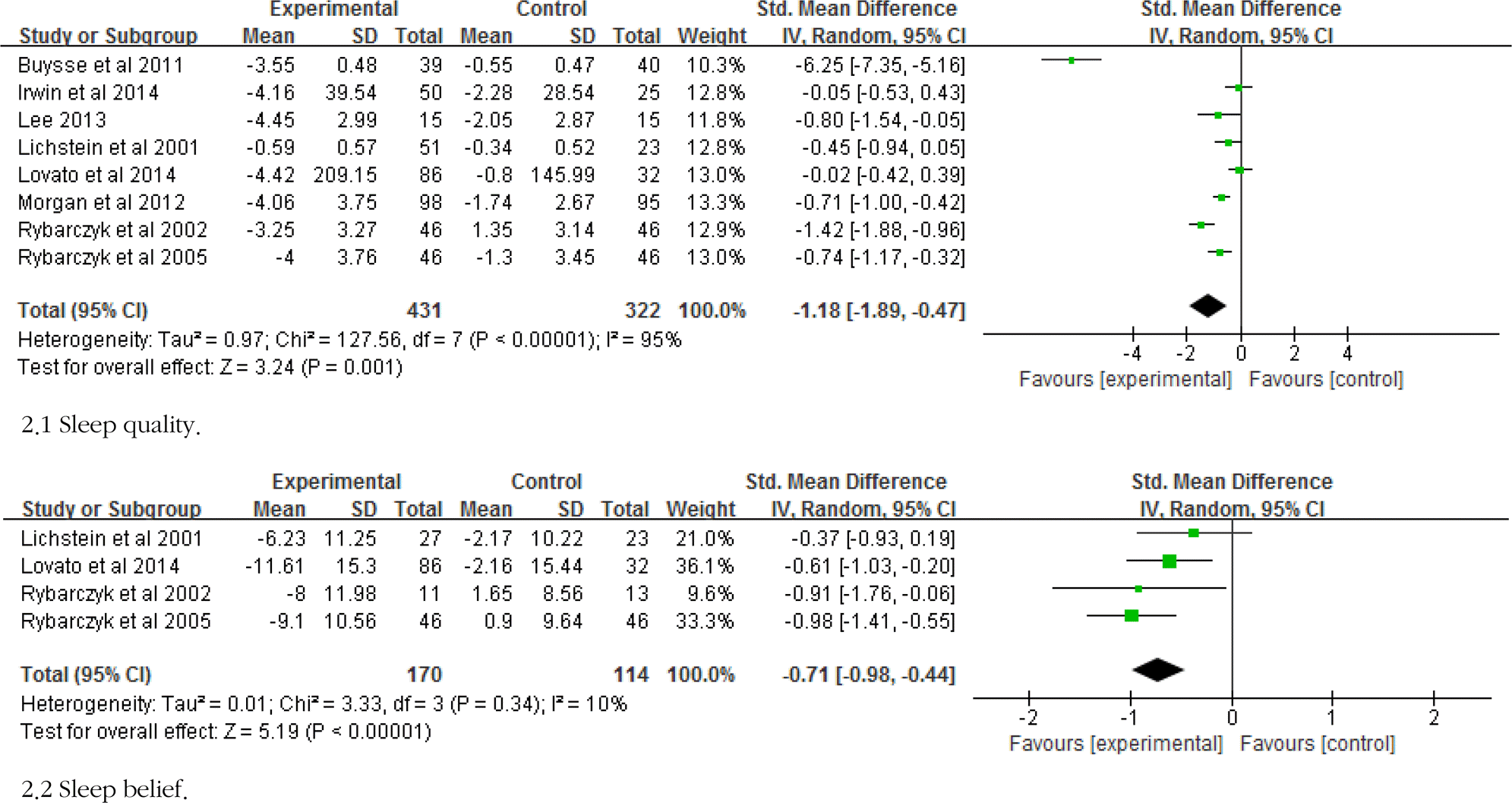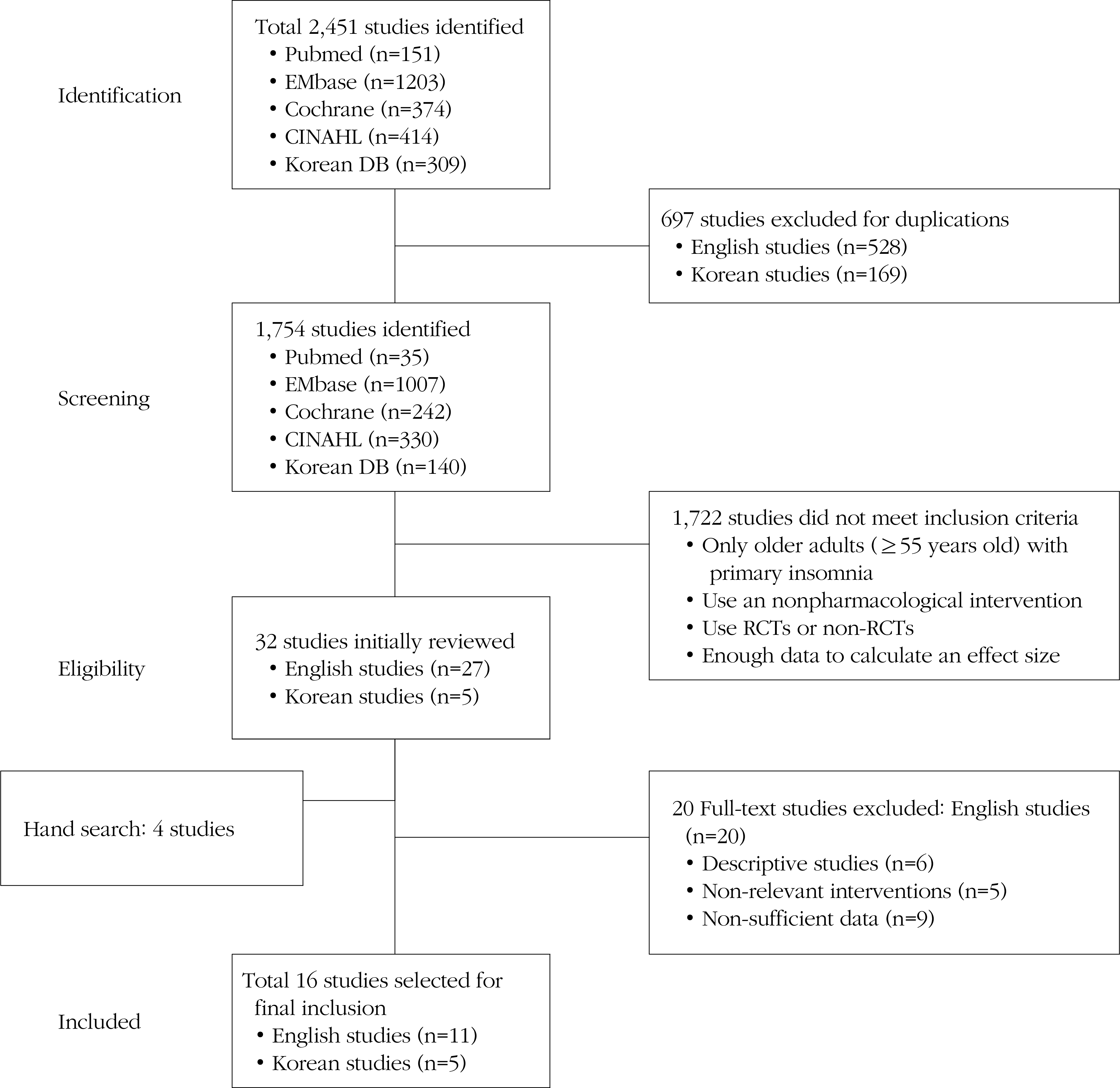1.Kwon KH., Suh SR., Suh BD. Sleep patterns and factors influencing sleep in institutionalized elders and elders living at home. Journal of Korean Gerontological Nursing. 2010. 12:131–41.
2.Basta M., Chrousos GP., Vela-Bueno A., Vgontzas AN. Chronic insomnia and stress system. Sleep Medicine Clinics. 2007. 2:279–91. http://dx.doi.org/10.1016/j.jsmc.2007.04.002.
3.Jun SS., Ha SJ. Sleep disorder experience in older patients with depression. Journal of Korean Academy of Nursing. 2014. 44(3):270–9. http://dx.doi.org/10.4040/jkan.2014.44.3.270.

4.Glass J., Lanctot KL., Herrmann N., Sproule BA., Busto UE. Sedative hypnotics in older people with insomnia: meta-analysis of risks and benefits. British Medical Journal. 2005. 331(11):69–75. http://dx.doi.org/10.1136/bmj.38623.768588.47.

5.Stepanski EJ. Hypnotics should not be considered for the initial treatment of chronic insomnia. Con. Journal of Clinical Sleep Medicine. 2005. 1(2):125–8.
6.Espie CA. Insomnia: conceptual issues in the development, persistence, and treatment of sleep disorder in adult. The Annual Review of Clinical Psychology. 2002. 53:214–43. http://dx.doi.org/10.1146/annurev.psych.53.100901.135243.
7.Koo YJ., Koh HJ. Analysis of intervention research about sleep of the elderly in Korea. Keimyung Journal of Nursing Science. 2009. 13(1):63–71.
8.Jaffe S., Patterson DR. Treating sleep problems in patients with burn injuries: practical considerations. Journal of Burn Care & Rehabilitation. 2004. 25(3):294–305. http://dx.doi.org/10.1097/01.BCR.0000124793.99886.6A.

9.Wang MY., Wang SY., Tsai PS. Cognitive behavioural therapy for primary insomnia: a systematic review. Journal of Advanced Nursing. 2005. 50(5):553–64. http://dx.doi.org/10.1111/j.1365-2648.2005.03433.x.

10.De Niet GJ., Tiemens BG., Kloos MW., Hutschemaekers GJ. Review of systematic reviews about the efficacy of non-pharmacological interventions to improve sleep quality in insomnia. International Journal of Evidence-Based Healthcare. 2009. 7(4):233–42. http://dx.doi.org/10.1111/j.1744-1609.2009.00142.x.

11.Montgomery P., Dennis JA. Cognitive behavioural interventions for sleep problems in adults aged 60+. Cochrane Database of Systematic Reviews. 2003. 1:CD003161. http://dx.doi.org/10.1002/14651858.CD003161.

12.Okajima I., Komada Y., Inoue Y. A meta-analysis on the treatment effectiveness of cognitive behavioral therapy for primary insomnia. Sleep and Biological Rhythms. 2011. 9(1):24–34. http://dx.doi.org/10.1111/j.1479-8425.2010.00481.x.

13.Cheng SK., Dizon J. Computerised cognitive behavioural therapy for insomnia: a systematic review and meta-analysis. Psychotherapy and Psychosomatics. 2012. 81(4):206–16. http://dx.doi.org/10.1159/000335379.

14.Kim SY., Park JE., Seo HJ., Seo HS., Song HJ., Shin CM, et al. NECA's guidance for undertaking systematic reviews and meta-analyses for intervention. Seoul: National Evidence-based Healthcare Collaborating Agency;2011.
15.Higgins JP., Green S. Cochrane handbook for systematic reviews of interventions, version 5.1.0. [updated March 2011]. The Cochrane Collaboration;Available from:. http://www.cochrane-handbook.org.
16.Cohen J. Statistical power analysis for the behavioral sciences. 2nd ed.Hillsdale, NJ: Lawrence Erlbaum Associates;1998.
17.Lee J. Meta-analysis. Journal of Korean Endocrine Society. 2008. 23(6):361–78. http://dx.doi.org/10.3803/jkes.2008.23.6.361.

18.Oh SS. Meta-analysis: theory and practice. Seoul: Konkuk University Press;2002.
19.Morin CM., Bootzin RR., Buysse DJ., Edinger JD., Espie CA., Lichstein KL. Psychological and behavioral treatment of insomnia: update of the recent evidence (1998-2004). Sleep. 2006. 29(11):1398–414.

20.Smith MT., Perlis ML., Park A., Smith MS., Pennington J., Giles DE, et al. Comparative meta-analysis of pharmacotherapy and behavior therapy for persistent insomnia. The American Journal of Psychiatry. 2002. 159:5–11.

21.Harvey L., Inglis SJ., Espie CA. Insomnias'reported use of CBT components and relationship to long-term clinical outcome. Behaviour Research and Therapy. 2002. 40:75–83.
22.Vincent N., Lionberg C. Treatment preference and patient satisfaction in chronic insomnia. Sleep. 2001. 24:411–7.

23.Oh PJ., Jang ES. Effects of psychosocial interventions on cortisol and immune parameters in patients with cancer: a meta analysis. Journal of Korean Academy of Nursing. 2014. 44(4):446–57. http://dx.doi.org/10.4040/jkan.2014.44.4.446.
24.Goedendrop MM., Gielissen MF., Verhagen CA., Bleijenberg G. Psychosocial interventions for reducing fatigue during cancer treatment in adults. The Cochrane Database of Systematic Reviews. 2009. 1:CD006953. http://dx.doi.org/10.1002/14651858.CD006953.pub2.
25.Morin CM., Culbert JP., Schwartz SM. Nonpharmacological interventions for insomnia: a meta-analysis of treatment efficacy. The American Journal of Psychiatry. 1994. 151(8):1172–80.
26.Sok SH., Kim KB. Effects of auricular acupuncture on insomnia in Korean elderly. Journal of Korean Academy of Nursing. 2005. 35(6):1014–24.

27.Kamel NS., Gammack JK. Insomnia in the elderly: cause, approach, and treatment. The American Journal of Medicine. 2006. 119(6):463–9. http://dx.doi.org/10.1016/j.amjmed.2005.10.051.

28.Schutte-Rodin S., Broch L., Buysse D., Dorsey C., Sateia M. Clinical guideline for the evaluation and management of chronic insomnia in adults. Journal of Clinical Sleep Medicine. 2008. 4:487–504.

29.Kwon KH. The development of measurement tool of sleep quality of the elderly [dissertation]. Daegu: Kyungpook National University;2009. p. 1–75.
30.Morin CM., Blais F., Savard J. Are changes in beliefs and attitudes about sleep related to sleep improvements in the treatment of insomnia? Behaviour Research and Therapy. 2002. 40:741–52.







 PDF
PDF ePub
ePub Citation
Citation Print
Print



 XML Download
XML Download